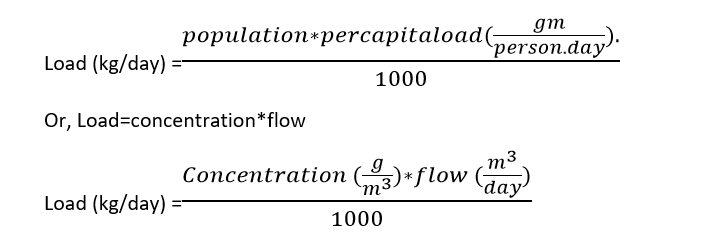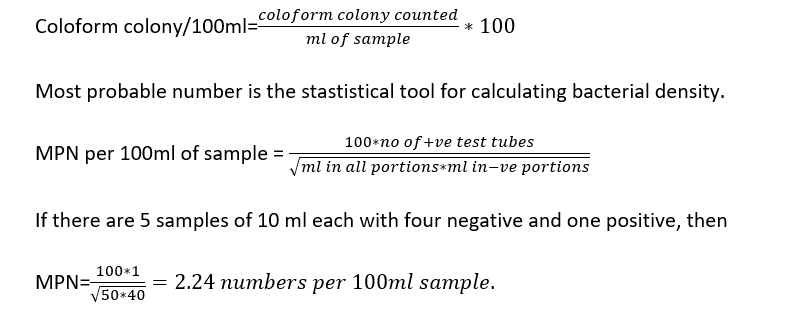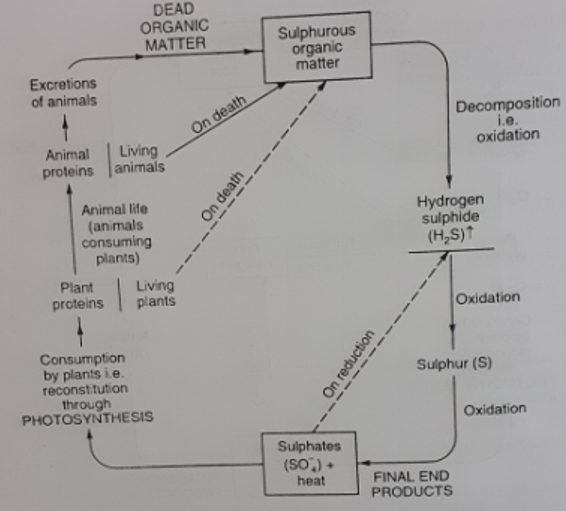1.1 Constituents of waste water:
- Waste water is the dilute mixture of various waste from residential areas, commercial, industrial and other public place.
- Before treatment and disposal it is essential to know it’s composition, quality and characteristics.
- Contains organic, inorganic matter and living organism.
- Physical constituents/impurities: grit, ash, sand, dirt etc.. They affect physical characteristics of waste water.
- Chemical constituents/impurities: All kind of dissolved, suspended and colloidal impurities that affects the chemical characteristics of the waste water.
- Biological constituents/impurities: Presence of all living microorganism (mostly micro organism) determines the biological characteristics of the waste water.
1.2 Characteristics of wastewater:
1. Physical characteristics and its examination
Four major parameter indicates the physical characteristics of waste water
- Turbidity:
Turbidity is the degree of clarity of waste water. Naturally, presence of different types of impurities causes sewage to be turbid. Higher turbidity implies that waste water is rigorously polluted. The degree of turbidity is measured by turbidity rod or turbidimeters. Turbidity rod is used for measuring turbidity in silica scale, it consist of an aluminum rod of about 203 mm long and graduated in ppm of silica scale (1 ppm=1mg/lt in silica scale=turbidity obtained from the solution of 1mg of silica in 1 liter of water). A screw containing a standard platinum needle (1mm diameter and 25mm long ) is inserted in the lower end. Graduated aluminum rod is lowered in water at the depth where platinum needle ceases to be seen and the value can be read on the graduated scale near the water surface.

This method gives the rough value only.
The other instruments used for the measurement of turbidity are
- Jackson turbidity meter
- Baylis turbidity meter
- Helge turbidity meter
- Nephelometer
Nephelometer is the digital instrument, that measures turbidity after calibration with standard turbidity solution. It measures turbidity in NTU.
- Color: Color in sewage appears due to presence of all different kind of impurities. Fresh sewage is brownish in color or slightly grey and with the passage of time, sewage becomes stale and darkens in color. It can be easily detected by naked eyes.
It is measured by platinum cobalt method. Various different concentration of standard solutions are made by dissolving various amount of platinum cobalt in distilled water and the color sample is compared with these solutions using tintometer. Tintometer consist of an eyepiece with two holes inside \, placing standard water and the sample water in these two different eyepieces, comparison is made. The standard solution is changed until the color in two slides matches.
- Odor: Fresh sewage has slightly soapy, earthy, relatively unpleasant and can be sometime completely odorless. As it becomes stale, it starts smelling due to the action of microbial activity which results hydrogen sulphide and other decomposition product.
Ordor is examined by threshold ordor number. In this test the water sample of known volume is mixed with taste and odor free water is mixed which makes the sample diluted to just make it ordor free.
Threshold order number = (A+B)/A
Where, A= volume of waste water sample
B= Volume of taste/ Odor free water added.
- Temperature: Normally the temperature of domestic and municipal sewage is slightly higher than that of the water supply, this happens with the presence of all kind of impurities and chemical reactions taking within. Observation of temperature of sewage is useful in indicating the solubility of oxygen which affects oxygen transfer capacity of aeration equipment’s and rate of biological activity. The ideal temperature for the biological activities is 20oC. Temperature variation also occurs due to variation in season of the year.
2. Chemical Characteristics:
Chemical characteristics of sewage indicate the sewage pollution extent and the type of treatment required. The basic chemical characteristics with test for determining are:
- Total solid, suspended and dissolved solid and settle able solid
Present in small amount (0.1%), solid can be in four different forms.
These solids can be both organic and inorganic matter. Organic matter consist of carbohydrate, fat, nitrogenous compounds etc and inorganic matter consist of minerals and salts.
Total solid is the sum of all kind of solid.
The estimation of suspended solids, both organic and inorganic, gives a general picture of the load on sedimentation and grit removal system during sewage treatment. Dissolved inorganic fraction is to be considered when sewage is used for land irrigation or any other reuse is planned.
Suspended solid: solids whose specific gravity are lighter and remains in floating stage.
Dissolved solid: those solids that are in dissolved stage in waste water.
Settleable solids: Those portions of solids (organic or inorganic) matter which settles out if sewage is allowed to remain undisturbed for a period of 2 hours.
Suspended solid content in a treated waste water must not exceed 50mg/lt before disposal.
- pH values:
pH of sewage represents the –ve logarithm of concentration of hydrogen ion. It is a valuable parameter in the operation of biological units. The pH of the fresh sewage is slightly more than the water supplied to the community. However, decomposition of organic matter may lower the pH, while the presence of industrial wastewater may produce extreme fluctuations. Generally the pH of raw sewage is in the range 5.5 to 8.0.
Dissolved oxygen DO
DO content represents the amount of oxygen in dissolved state in sewage. It is an important parameter that indicates the purity of water and hence waste water. In case of sewage, if it is too polluted, a situation may arise when it has no DO content, in such cases it becomes important to increase the DO content of sewage by aeration. Presence of DO content facilitates aerobic decomposition of waste water. After treatment, it is important that sewage contain at least 4 ppm DO content before disposing to the receiving water value. 4 ppm DO content is required to maintain the aquatic life of the water bodies. It is determined by wrinklers method in lab.
Organic Matter
Heterogenous mixture of various organic compounds, Main component carbohydrate, protein and fats. Organic matter are determined by two method
Direct method: This involves determination of total organic carbon.
Indirect method: BOD5, COD and ultimate BOD
BOD and COD
Organic compounds present in sewage are of particular interest for environmental engineering. A large variety of microorganisms (that may be present in the sewage or in the receiving water body) interact with the organic material by using it as an energy or material source. The utilization of the organic material by microorganisms is called metabolism. To describe the metabolism of microorganisms and oxidation of organic material, it is necessary to characterize quantitatively concentration of organic matter in different forms. In view of the enormous variety of organic compounds in sewage it is totally unpractical to determine these individually. Thus a parameter must be used that characterizes a property that all these have in common. In practice two properties of almost all organic compounds can be used: (1) organic compound can be oxidized; and (2) organic compounds contain organic carbon. In environmental engineering there are two standard tests based on the oxidation of organic material:
The Biochemical Oxygen Demand (BOD) and Chemical Oxygen Demand (COD) tests.
In both tests, the organic material concentration is measured during the test. The essential differences between the COD and the BOD tests are in the oxidant utilized and the operational conditions imposed during the test such as biochemical oxidation and chemical oxidation. The other method for measuring organic material is the development of the Total Organic Carbon (TOC) test as an alternative to quantify the concentration of the organic material.
Biochemical Oxygen Demand (BOD):
The BOD of the sewage is the amount of oxygen required for the biochemical decomposition of biodegradable organic matter under aerobic conditions. The oxygen consumed in the process is related to the amount of decomposable organic matter. The general range of BOD observed for raw sewage is 100 to 400 mg/L. Treated wastewater BOD must not exceed 30mg/lit before disposal to receiving body.

Per capita load
It represents average contribution of each individual expressed in terms of pollutant mass per unit time. Commonly used is (gm/person.day). Eg BOD gm/person.day for domestic sewage is 40.
Load=population*per capita load

Note: g/m3=mg/L
BOD calculation in lab
Only in the condition when the waste water has sufficient oxygen content required for complete decomposition of organic matter, it is possible to find the BOD. Highly polluted water often lacks DO content to meet the demand. In this case, waste water sample are diluted with clean water having sufficient DO content.
BOD5=DO consumed by the diluted sample*(Dilution factor)

1% diluted sample means 1ml of sewage is diluted to make 100ml of test solution
Chemical Oxygen Demand (COD):
The COD gives the measure of the oxygen required for chemical oxidation. It does not differentiate between biological oxidable and non oxidable material. However, the ratio of the COD to BOD does not change significantly for particular waste and hence this test could be used conveniently for interpreting performance efficiencies of the treatment units. In general, the COD of raw sewage at various places is reported to be in the range 200 to 700 mg/L. In COD test, the oxidation of organic matter is essentially complete within two hours, whereas, biochemical oxidation of organic matter takes several weeks. In case of wastewaters with a large range of organic compounds, an extra difficulty in using BOD as a quantitative parameter is that the rate of oxidation of organic compounds depends on the nature and size of its molecules. Smaller molecules are readily available for use by bacteria, but large molecules and colloidal and suspended matters can only be metabolized after preparatory steps of hydrolysis. It is therefore not possible to establish a general relationship between the experimental five-day BOD and the ultimate BOD of a sample, i.e., the oxygen consumption after several weeks. For sewage (with k=0.23 d-1 at 20oC) the BOD5 is 0.68 times of ultimate BOD, and ultimate BOD is 87% of the COD. Hence, the COD /BOD ratio for the sewage is around 1.7.
- Nitrogen
The presence of nitrogen in sewage indicates the presence of organic matter, the principal nitrogen compounds in domestic sewage are proteins, amines, amino acids, and urea.
The various form of nitrogen in sewage are
- Free ammonia
- Albuminoidal nitrogen called organic nitrogen
- Nitrites
- Nitrates
Ammonia nitrogen in sewage results from the bacterial decomposition of these organic constituents and indicates the very first state of decomposition. Nitrogen being an essential component of biological protoplasm, its concentration is important for proper functioning of biological treatment systems and disposal on land. Generally, the domestic sewage contains sufficient nitrogen, to take care of the needs of the biological treatment. For industrial wastewater if sufficient nitrogen is not present it is required to be added externally.
Albuninoid nitrogen indicates the quantity of nitrogen present in sewage before the decomposition of the organic matter is started.
Nitrites indicate the presence of partly decomposed organic matter.
Nitrate indicates the presence of fully oxidized organic matter.
The test on nitrogen confirms the decomposition stage of organic matter. For example if nitrite is present then it indicates incomplete decomposition however if nitrate is present it shows that sewage is well oxidized. It is however important to limit the concentration of nitrate before disposal as it may cause nitrate poisoning.
In infant it nitrate rich water causes blue baby disease.
Nitrogen compound leads to a phenomenon of eutrophication.
In the process of conversion of ammonia to nitrite and nitrate, oxygen are consumed this reduces DO content.
Free ammonia is measured by boiling of sewage and measuring the gas.
Albuminoid nitrogen is measure by adding potassium permanganate to the boiled sewage.
If unboilded sample is used to add potassium permanganate, it gives the sum of ammonia nitrogen and organic nitrogen which is known as kjedahl nitrogen.
Nitrite is measured by color matching method by adding sulphonilic acid and napthamine.
Nitrates is measured by adding phenol di sulphonic acid and potassium hudroxide. Generally nitrogen content in the untreated sewage is observed to be in the range of 20 to 50 mg/L measured as TKN or 45 ppm nitrate.
- Phosphorus
Phosphorus is contributing to domestic sewage from food residues containing phosphorus and their breakdown products. The use of increased quantities of synthetic detergents adds substantially to the phosphorus content of sewage. Phosphorus is also an essential nutrient for the biological processes. The concentration of phosphorus in domestic sewage is generally adequate to support aerobic biological wastewater treatment. However, it will be matter of concerned when the treated effluent is to be reused. It is essential for microorganism growth but in excess amount it leads to eutrophication. The concentration of PO4 in raw sewage is generally observed in the range of 5 to 10 mg/L.
- Chlorides:
Municipal water contains large quantity of chlorides, derived form the kitchen wastes, human feaces and urinary discharges etc. The normal chloride content is 120 ppm however in water supplies it is accepted to 250ppm.
Concentration of chlorides in sewage is greater than the normal chloride content of water supply. The chloride concentration in excess than the water supplied can be used as an index of the strength of the sewage. The daily contribution of chloride averages to about 8 gm per person. Based on an average sewage flow of 150 LPCD, this would result in the chloride content of sewage being 50 mg/L higher than that of the water supplied. Any abnormal increase should indicate discharge of chloride bearing wastes or saline groundwater infiltration, the latter adding to the sulphates as well, which may lead to excessive generation of hydrogen sulphide.
- Oil and grease:
These are fraction of organic matter that are soluble in hexane. It constitutes about 10 % of total organic matter.
3. Biological characteristics:
Bacterial and Micro-organisms present abundantly in sewage (5-15 billion per liter of sewage). All kind of microorganisms such as algae, fungi, protozoa etc are present. Bacteria are the most diverse group of microorganisms which are the minute single cell microorganisms possessing no defined nucleous and having no definite shapes. Most of the bacteria area harmless called nonpathogenic bacteria, however some of them are harmful and causes serious diseases and called as pathogenic bacteria.
Most of the bacterial require oxygen for their survival, they consume DO and decompose the refuse and organic matter present in water or sewage. They are called aerobic bacteria. Some of them do not require oxygen and are called anaerobic bacteria, they also decompose organic matter for their consumption where are there is one different set of bacteria that can survive with and without oxygen.
Presence of bacteria facilitates sewage decomposition however the concern is of pathogenic bacteria. In case of sewage, test of microorganism is not performed because of the high concentration of bacteria but at the time of epidemiological investigation certain test may be required.
Indicator organism
All bacteria present in nature are not harmful to us, only disease causing bacteria poses direct threat to human health, these are called pathogens. Large number of bacteria resides in the colon of human and animal, naturally, these different bacteria make their way out to the atmosphere through human and animal excreta. The main objective of bacteriological test is to ascertain contamination of excrete, since excreta contains different types of bacteria, the most common E coli is taken as an indicator organism. E coli is relatively in large number about millions per 100ml of crude waste water, whereas pathogens are few and their survival rate is quite low. The benefit of adopting E coli as indicator organism is that the presence of E coli indicates the contamination of water with excreta and hence alerts about the possible presence of pathogens.
Introduction to biological analysis: membrane filter test
Test conducted for examine microorganism with use of membrane filter. The filter consist of large number of microscopic pores that are capable of retaining bacteria.
The procedure for the test is
- Waste water sample is filtered through the membrane filter and the membrane is then placed on a sterilized pad absorbed with nutrient (M-Endo’s medium) this inhibits the growth of bacteria other than coliform group.
- It is then placed in an incubator at 37oC for a period of 20 hours
- If the coliform bacteria are present the colonies of coliform group bacteria can be seen through microscope.

1.3 Aerobic and anaerobic decomposition:
1. Aerobic decomposition:
- Natural biological degradation and purification process in which bacteria grows in presence of air or dissolved oxygen.
- Example: Aeration tank, trickling filter etc.
Advantage:
- Aerobic bacteria are very efficient in breaking down waste product.
- Aerobic pathway releases substantial amount of energy.
2. Anaerobic decomposition:
- Biological process in which decomposition of organic matter occurs without oxygen.
- Example: Septic tank, digestion tank etc.
Advantage:
- Waste water pollutant are transformed into methane.
- Biomass growth is less.
1.4 Cycle of decomposition:
1. Nitrogen cycle:

2. Carbon cycle:

3. Sulphur cycle:

1.5 Expression of BOD:
BOD represents amount of oxygen required for biological decomposition of organic matter. However oxidation of organic matter occurs in two stage, first stage is a rapid process which completes in 7 to 10 days where most of the carbonaceous matters get oxidized, this stage is dependent on temperature and characteristics of sewage. On the other hand second stage BOD curve represents rate of oxidation of nitrogenous matter and the process is called nitrification.


t=time (days)
Lt=Amount of first stage BOD remaining or oxygen equivalent of organic matters left after t days in (mg/l)
Lo= Amount of first stage BOD remaining or oxygen equivalent of organic matters left at beginning or at t=0 days in (mg/l)
Yt= Amount of first stage BOD exerted or oxygen equivalent of organic matters oxidized after t days in (mg/l)
For first stage decomposition at the given temperature it is assumed that the rate of deoxygenation or decomposition is proportional to the amount of organic matter present at that time.

-ve sign indicates that with passage of time the value of decreases
Where K is decomposition constant and its unit is per day.
Integrating on both sides

Where C is constant of integration, the value of which is calculated from the boundary condition.
When t=0, Lt = Lo
Therefore, C=Loge Lo Substituting value of C in equation 1

Using, 0.434K= KD
Where KD is the decomposition constant or BOD rate constant on base 10 at the given temperature.
Rewriting equation 2

For BOD exerted,
We know that,

Relative stability
Ratio of available oxygen to the required oxygen for decomposition of organic matter present in waste water. The available oxygen can be in the form of DO, nitrite or nitrate.
Indicates the character of sewage
S = 100 (1 – 0.794T20) or
S=100 (1-0.630 T37)
Where T20 = no. of days, required to decolorize a standard volume of methylene blue solution by a sewage when incubated at 200C and 37 degrees respectively
Population Equivalent
It is a term used to indicate strength of industrial sewage equivalent to population as of BOD.

References:
- Modi, P.N. Environmental Engineering, Volume II : Waste Water Treatment, Disposal and Air Pollution Engineering. Delhi: Standard Book House.
- Garg. S.K. Environmental Engineering (Vol. II): Waste Water Engineering. Delhi: Khanna Publishers.

